-
 Hi Guest!
Hi Guest!
If you appreciate British Car Forum and our 25 years of supporting British car enthusiasts with technical and anicdotal information, collected from our thousands of great members, please support us with a low-cost subscription. You can become a supporting member for less than the dues of most car clubs.
There are some perks with a member upgrade!**Upgrade Now**
(PS: Subscribers don't see this gawd-aweful banner

Tips
- We have a special forum called "Member Articles" where you can submit actual articles for consideration for publication. Learn More
- Don't have an Avatar? If not, your avatar will default to the 1st character in your username. Go into "Account Details" to change your Avatar.
- Some basic forum navigation info: click
Hey - did you know if you click on the title of a thread it will take you to the first unread post since you last visited that thread?
- Hey Guest - Is your British Car Club in our Clubs database? If not, send me a PM - Basil

- Looking for a local club? Click the "Clubs" tab above and browse hundreds of clubs world-wide.
- Add Android or iPhone APP: click
- Did you know - any picture or video you add in your posts in any marque-specific forum will also get added to the Media Gallery automatically.
- A few more tips about posting and replying: click
- Hey there Guest - be sure to keep your profile page up to date with interesting info about yourself: learn more
- More tips and tricks on Posting and Replying: click
 STOP!! Never post your email address in open forums. Bots can "harvest" your email! If you must share your email use a Private Message or use the
STOP!! Never post your email address in open forums. Bots can "harvest" your email! If you must share your email use a Private Message or use the  smilie in place of the real @
smilie in place of the real @
- Want to mention another member in a post & get their attention? WATCH THIS

- So, you created a "Group" here at BCF and would like to invite other members to join? Watch this!
- Hey Guest - A post a day keeps Basil from visiting you in the small hours and putting a bat up your nightdress!
- Hey Guest - do you know of an upcoming British car event?
 Pretty Please - add it to our Events forum(s) and add to the calendar! >> Here's How <<
Pretty Please - add it to our Events forum(s) and add to the calendar! >> Here's How << 
- Hey Guest - you be stylin'
Change the look and feel of the forum to fit your taste. Check it out
- If you run across an inappropriate post, for example a post that breaks our rules or looks like it might be spam, you can report the post to the moderators: Learn More
- If you would like to try some different "looks" or styles for the site, scroll to the very bottom, on the left and click the Style Selector.
You are using an out of date browser. It may not display this or other websites correctly.
You should upgrade or use an alternative browser.
You should upgrade or use an alternative browser.
BJ8 Rear Wheel Cylinder leaking
- Thread starter AUSMHLY
- Start date
Bob_Spidell
Yoda
Offline
Been a while since I've done this, but IIRC I used a hammer and drift to tap it out from the edges.
Bob_Spidell
Yoda
Offline
Yes (one is called a 'plate' and one a 'spring' in the Moss catalog). They overlap, and interlock with a couple tabs (again, IIRC). Tap one out--presumably, the top one--then the other in the other direction.
Edit: The morning fog is clearing: The 'spring'--I think it's on top--has a couple 'hooks' (just a couple bends) on one end to entrap the 'plate' (unless I have this bass-ackwards). It'll be evident once you have a look (getting them off is the easy part).
Edit: The morning fog is clearing: The 'spring'--I think it's on top--has a couple 'hooks' (just a couple bends) on one end to entrap the 'plate' (unless I have this bass-ackwards). It'll be evident once you have a look (getting them off is the easy part).
AUSMHLY
Yoda
Offline
Yup, thought that. This is the first time for me. Gut feeling, the plate is bowed to keep pressure? I tried to get a screwdriver in there and tap it. Thank goodness there's so much room to do that. The cylinder kept sliding, brake fluid on my hands, screwdriver, hammer, plate, floor, everything was slippery, it's dark, even with the flashlight, keep banging my head in the wheel well. All good times!
Randy Forbes
Yoda
Offline
Dynamite is the logical answer...How do I remove the clip that holds the rear cylinder in place?

AUSMHLY
Yoda
Offline
Don't you love replying to your own post, lol.How do I remove the clip that holds the rear cylinder in place?
Reason I could not tell how the clips hold the cylinder in place is because when it's covered in dirt/grime you can't tell there are 2 tabs on the lower "spring" plate that hold the top "plate" in place.
Those 2 small tabs on the lower spring plate need to be pushed down to let the top plate slide forward.
Now it makes sense why the tapping on the edge of the top plate didn't move it.
Here's a break down how the clip system works.
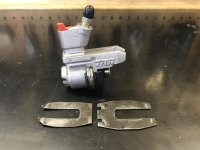
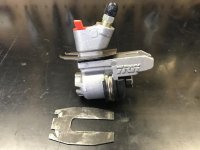
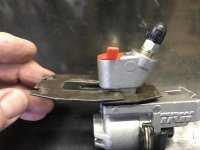
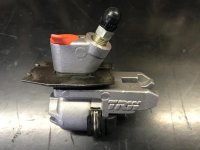
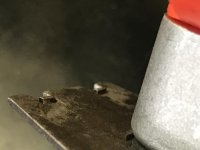
Last edited:
Offline
Good photos.
AUSMHLY
Yoda
Offline
Kudos to John Turney for helping me with my brake system. What I thought was going to be replacing one leaking rear cylinder, turned into a complete system overhaul. John drove to my house...twice... and helped me replace both rear cylinders and brake shoes. We replaced the front disc seals, master brake cylinder, master clutch cylinder and slave. We replaced all rubber hoses with stainless steel. Bleed the system with Castro Dot 4. This was my first attempt at working on brakes. I started this project on June 17 and finished on August 1st. John I appreciate all your help, knowledge and time. It was a pleasure meeting you. Thank you John!
D
Deleted member 8987
Guest
Guest
Offline
Standard shop procedure is always do everything the same on one axle (or end of vehicle). Replace or rebuild one caliper or cylinder, do the same to the other. They have exactly the same fluid to them and number of stroke cycles. Period.
Shoes and pads...well, let's think about this. There are different compositions...if for some reason you have very few miles and yours are old enough to still contain asbestos....those had better coefficient of friction than modern.
One PRC manufacturer may have a different modern compositions than another manufacturer...same with US.
In all the years I did this, we found on 4-wheel drum braked US cars, newer compositions would_not_stop the vehicle, even with two boots on the pedal without power assist (think early Mustangs and early Ford V8's). BTDT. Had a local reliner who had A-B lining, stopped just like old asbestos linings. Then there were Mountain Brakes that worked VERY well, but wore out twice as fast.
Do both sides, and yes, you cannot get oils and fluid out of the porous lining material. Even using Lacquer thinner and sandpaper.....and hours of work...and you end up changing them anyway.
Then there are off-gassing issues....and we found riveted linings had far less issue than bonded linings. Gasses had some place to go, or so it was explained to me decades ago. Racing drum brakes we'd drill a number of holes through the lining and shoe to allow off-gassing to escape.
Shoes and pads...well, let's think about this. There are different compositions...if for some reason you have very few miles and yours are old enough to still contain asbestos....those had better coefficient of friction than modern.
One PRC manufacturer may have a different modern compositions than another manufacturer...same with US.
In all the years I did this, we found on 4-wheel drum braked US cars, newer compositions would_not_stop the vehicle, even with two boots on the pedal without power assist (think early Mustangs and early Ford V8's). BTDT. Had a local reliner who had A-B lining, stopped just like old asbestos linings. Then there were Mountain Brakes that worked VERY well, but wore out twice as fast.
Do both sides, and yes, you cannot get oils and fluid out of the porous lining material. Even using Lacquer thinner and sandpaper.....and hours of work...and you end up changing them anyway.
Then there are off-gassing issues....and we found riveted linings had far less issue than bonded linings. Gasses had some place to go, or so it was explained to me decades ago. Racing drum brakes we'd drill a number of holes through the lining and shoe to allow off-gassing to escape.


